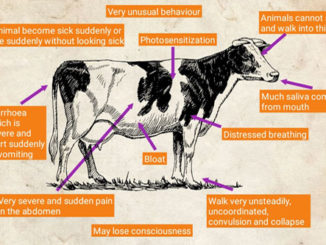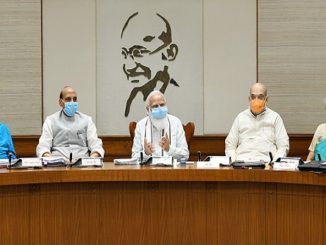Introduction
Livestock is considered a major source of income for the poor developing countries like India. It contributes, nearly 4.11 percent to total GDP and 25.6% of total Agriculture GDP. Present livestock population of 535.78 million registered an increase of 4.6% over Livestock Census 2012. Pesticides are chemicals to control a variety of pests that can damage crops and livestock and reduce farm productivity. Pesticides play a sensitive role in agriculture as they are applied in order to protect crops, but they can have negative impacts on environment and human health. The production of pesticides started in India in 1952 with the establishment of a plant for the production of BHC near Calcutta, and India is now the second largest manufacturer of pesticides in Asia after China and ranks twelfth globally for the consumption (Mathur, 1999). There has been a steady growth in the production of technical grade pesticides in India, from 5,000 metric tonnes in 1958 to 102,240 metric tonnes in 1998. Apart from pesticides used for crop production, their indiscriminate usage during storage also play a role in the case of oil cakes, grains and milling products. Contamination of the soil and water sources used for drinking purpose of animals also forms another source of pesticide residue in animals. The pesticides cover a wide range of compounds including insecticides, fungicides, herbicides, rodenticides, molluscicides, nematicides, plant growth regulators and others.
Types of pesticides
Organophosphate pesticides
Organophosphate (OP) compounds are a group of pesticides that includes some of the most toxic chemicals used in agriculture. OP toxicity is due to the ability of these compounds to inhibit an enzyme, acetyl cholinesterase at cholinergic junctions of the nervous system. Most organophosphates are insecticides like diazinon, malathion, coumaphos.
Organochlorine insecticides
It includes pesticides like DDT, chlordane, aldrin, dieldrin, heptachlor etc compounds.
Carbamate pesticides
These pesticides also affect the nervous system by disrupting an enzyme system. There are several subcategories within the carbamates like Aldicarb, carbofuran, carbaryl, carbosulfan etc are the example of carbomates.
Pyrethroid pesticides
Some of the commonly used pyrethroid are Deltamethrin, cypermethrin, permethrin.
Sources of pesticide residues in Livestock
Pesticides are found as common contaminants in soil, air, water and on non-target organisms in our urban landscapes. Once there, they can harm plants and animals ranging from beneficial soil microorganisms and insects, non-target plants, fish, birds, and other wildlife (USGS, 1995). Repeated and excessive use of pesticides in agriculture to the development of resistance in many insects/ pests. Residues in food for humans and feed for livestock can be a consequence of direct application of a chemical to the food source, by the presence of pollutants in the environment or by transfer and biomagnification of the chemical along a food chain. Pesticide poisoning of animals commonly associated with human error. Errors include improper dosage, use of improper compounds or formulations, use of treated seed as feed, improper spraying and improper storage and disposal of pesticide containers.
Effects of pesticide residues on livestock
Pesticide residues in livestock generally accumulate by two ways either through direct application on animals or on agricultural crops and fodder (Poppenga, 1999). The livestock reared on pesticides contaminated soils, crops, and fodders may accumulate considerable residues in edible tissues. Furthermore, pesticide residues also accumulate on cropland soil (Jabbar et al., 1993). Animals can accumulate these substances from contaminated feed and water. Also, due to the lipophilic nature of these pesticides, milk and other fat rich substances are the key items for their accumulation (John et al., 2001). Therefore, an indirect source of pesticides accumulation can be represented by animal-derived products. Kaphalia and Seth found amongst all meat products, greatest contamination was observed in chicken muscle followed by goat and beef collected in Lucknow, India. The cumulative occurrences of pesticide residues in the meat and milk are of a great concern for ensuring food safety and human health.
Pesticides have been associated with serious adverse effects in birds, man and animals like causing carcinogenicity , teratogenicity, immunosuppression, embrotoxicity, infertility and birth defects, and several others like Hepatotoxicity, Nephropathy, Mutagenicity and Hypersensitivity etc.
Pesticides in the environment may play an important role in contributing to underlying causes of fertility problems in dairy livestock. In females the pesticide exposure induced alterations which include poor reproductive behavior, sub-fecundity, infertility, pregnancy loss, growth retardation, intra-uterine fetal demise and ovarian failure. Pesticide residues can be detrimental to male reproductive system by causing toxicity to sperm plasma membrane (Campagna et al., 2009). Depending on the chemical properties of synthetic insecticides, they can enter the organism, bio-accumulate in food chains and consequently influence also human health.
Benefits of pesticides
Pesticides, when used properly, improve health and agricultural production with negligible side effects. They control the vector borne diseases like malaria, trypanosomiasis and leishmaniasis etc and thus improve the health of animals, directly related to economy of the farmers.
Pesticides banned
Aldicarb, Aldrin, BHC, Calcium Cyanide, Captafol, Carbofuran, Chlordane, Chlorobenzilate, Cibromochloropropane, Dieldrin, Endrin, Ethyl Parathion, Heptachlor, Menazone, Methamol, Nicotine sulphate, Toxafen
Conclusion
Pesticides have become increasingly for agricultural, industrial, livestock husbandry and home use and represent a significant potential health risk for human and livestock. The presence of pesticide residues in all the animal products is chief concern relating to human health, animal health and its products. Organic farming is the beneficial tool to combat the problems related to pesticide residue. Establishing regulatory standard and management practices of using the pesticides are the alternative ways to prevent the adverse effect of pesticide residue on the environment.
References
- Campagna C, Guillemette C, Ayotte P, Bailey JL. (2009). Effects of an environmentally relevant organochlorine mixture and a metabolized extract of this mixture on porcine sperm parameters in vitro. Journal of Andrology. 30:317–24.
- Jabbar, A., Masud, S.Z., Perveen, Z. and Mubarik, A. (1993). Pesticides residue in cropland soils and shallow groundwater in Punjab, Pakistan. Bull. Environ. Contam. Toxicol., 51(2) :112-118.
- John, P.J., Bakore, N. and Bhantnagar, P. (2001). Assessment of organochlorine pesticides residue levels in dairy milk and buffalo milk from Jaipur city, Rajasthan, India, Enviro. Internat., 26 : 231- 236.
- Kaphalia BS, Seth TD. (1981). DDT and BHC residues in some body tissues of goats, buffalo and chickens from Lucknow, India. Pesticide Monitory Journal.15:103-106.
- Mathur SC. (1999). Future of Indian pesticides industry in next millennium, Pesticide Information.24(4):9-23.
- Poppenga, R.H. (1999). Current environmental threats to animal health and productivity. J. Nat.Toxins. 8(1): 47-55.
- UNEP. (1991). Chemicals of global concern: Priorities for action. J of the International Register of Potentially Toxic Chemicals devoted to information on hazardous chemicals.10: (2)23-43.






Be the first to comment